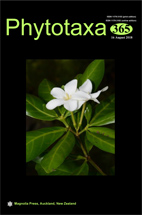Abstract
The genus Pecluma M. G. Price (1983: 109) comprises terrestrial, epiphytic or epilithic ferns, usually medium-sized. Currently, 40 species belonging to the genus are recognized, occurring in the warmer parts of the New World, from Florida to northern Argentina, with a unique set of characteristics: short-creeping, non-glaucous rhizomes with basifixed, pseudopeltate to peltate scales, often terete stipes and rachises, pinnatisect or pectinate-pinnatifid blades with numerous linear or narrowly deltate segments, and sterile lamina parts with acicular cells beside multicellular branched or unbranched glandular hairs (Price 1983; Hennipman et al. 1990; Moran 1995, Assis et al. 2016).
References
Evans, A.M. (1969) Interspecific relationships in the Polypodium pectinatum-plumula complex. Annals of the Missouri Botanical Garden 55: 193–293.
https://doi.org/10.2307/2395127
Fée, A.L.A. (1869) Cryptogames vasculaires (fougeÌres, lycopodiaceìes, hydropteìrideìes, equiseìtaceìes) du Brésil matériaux pour une flore générale de ce pays. Paris: J. B. BaillieÌre et Fils, 267 pp.
Hennipman, E., Veldhoen, P., Kramer, K.U. & Price, M.G. (1990) Polypodiaceae. In: Kubitzki, K. (Ed.) The Families and Genera of Vascular Plants. Volume I. Springer-Verlag, New York, pp. 203–230.
Kessler, M. & Smith, A.R. (2005) Seven new species, 13 new combinations, and one new name of Polypodiaceae from Bolivia. Candollea 60: 271–288.
Langsdorff, G.H. & Fischer, F.E.L. (1810) Plantes recueilles pendant le voyage des Russes autour du monde: expeìdition dirigeìe par M. de Krusenstern. Tubingue, Chez J.G. Cotta, 26 pp + 30 plates.
http://dx.doi.org/10.3931/e-rara-17045
Martinez, O.G., Assis, F.C., Meza Torres E.I., Cacharani, D.A. & Jaimez, D.G. (2016) Pecluma. In: Ponce, M.M. & Arana, M.D. (Coord.) Flora Argentina. Volumen 2. Licofitas, Helechos, Gymnospermae. Buenos Aires, Instituto de Botánica Darwinion, pp. 252–258.
McNeill, J., Barrie, F.R., Buck, W.R., Demoulin, V., Greuter, W., Hawksworth, D.L., Herendeen, P.S., Knapp, S., Marhold, K., Prado, J., Prud’homme van Reine, W.F., Smith, G.F., Wiersema, J.H. & Turland, N.J. (2012) International Code of Nomenclature for algae, fungi, and plants (Melbourne Code): adopted by the Eighteenth International Botanical Congress Melbourne, Australia, July 2011. Regnum Vegetabile 154: 1–274.
Moran, R.C. (1995) Pecluma. In: Davidse, G., Sousa, M. & Knapp, S. (Ed.) Flora Mesoamericana. Psilotaceae a Salvinaceae. Ciudad de México: Universidad Nacional Autónoma de México, pp. 341–345.
Price, M.G. (1983) Pecluma, a New Tropical American fern genus. American Fern Journal 73: 109–116.
https://doi.org/10.2307/1546961
Triana-Moreno, L.A. (2015) Catálogo comentado de las especies de Pecluma (Polypodiaceae) de Colombia. Boletín Científico. Centro de Museos. Museo de Historia Natural 19: 17–59.

